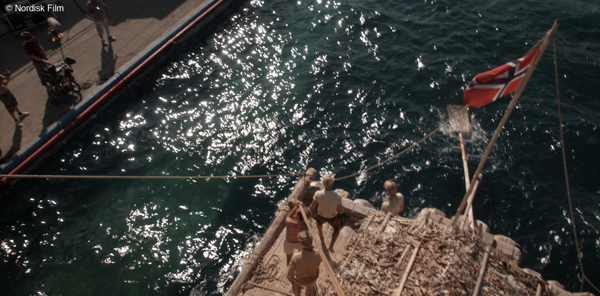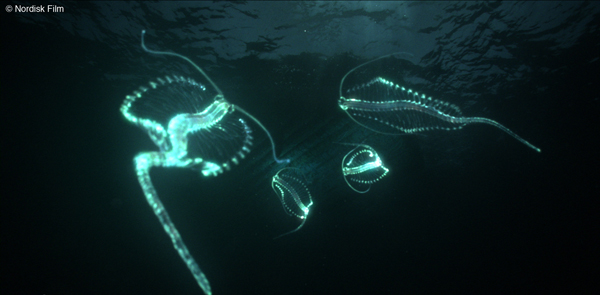
Fido visual effects studio in Stockholm has brought realism and natural wonder to ‘Kon-Tiki’, a new Norwegian feature on Thor Heyerdahl’s ocean voyage.
KON-TIKI – Crossing the Pacific |
|
Fido visual effects studio in Stockholm has brought realism and natural wonder to ‘Kon-Tiki’, a new Norwegian feature on Thor Heyerdahl’s ocean voyage. Producer Aage Aaberge contacted Fido in May 2011, while still in the early stages of pre-production for what has become Norway’s largest feature film production so far, ‘Kon-Tiki’. The movie, directed by Joachim Rønning and Espen Sandberg, is a dramatization of the explorer Thor Heyerdahl’s famous crossing of the Pacific on a balsa wood raft in 1947. |
  |
| Because all of the main action sequences were shot in a tank located in Malta, extending the water was a principle task. Staffan Linder from Fido attended the shoot, where the tank was equipped with wave machines to produce a choppy water surface. The tank was located on a height overlooking the sea with the intention of capturing a natural horizon line for shots on the open sea. “However because the colour and choppiness of the water in the tank did not match the sea as well as expected, we ended up with a lot of clean-up and horizon replacements.” said Fido’s VFX supervisor Mattias Lindahl. Water R&D “Prior to Kon-Tiki, we had worked on other projects with a strong water element here at Fido for which we had done quite a bit of research already. For instance, we have developed our own in-house fluid solver, SpeedSPH, that runs on the GPU. For this project, though, we decided to use a Houdini/V-Ray workflow for the extensions. It is the first time we have used V-Ray for a feature film project and we were very happy with the result,” Mattias said. |
  |
| “We had to do some up-front R&D to our pipeline to get V-Ray to talk to Houdini. This work was led by our lighting TD Johan Gabrielsson and FX artist Björn Henriksson. We used the vector displacement within V-Ray to create the main water surface. The vector displacement texture was then baked and sent to Houdini where the wakes, splashes and foam were created. We then passed those water elements back from Houdini as textures and V-Ray proxies and rendered it out with V-Ray.” It was important to be able to keep as much real water from the plate as possible, especially in the immediate area close to the raft, where interactions would be visible. They did have to replace the entire water surface in some shots, but tried as much as possible to limit this only to the wider shots. Seaming the practical and CG water together was more straightforward than what they first anticipated. “We basically started off by matching the sun position to the plate on our CG water,” explained Mattias. “We then tweaked our displacement textures to match the choppiness and density of the live action water. The rest was just plain old elbow grease in compositing, creating animated soft mattes for the seam between the two elements. The real trick here, obviously, was getting a good match on the CG, to give the compositors a fair chance of matching the look of the real water, and this approach worked very well.” |
  |
 |
| Creature Research While the Fido team wished the budget would have allowed for an exciting research trip to study exotic species of fish and whale, unfortunately it didn’t. In a more cost conscious mode, they had to resort to research on the Internet and natural history documentaries. “The production VFX supervisor Arne Kaupang supplied us with names and some references of different species of fish that he wanted to been seen gathering under the raft, and we closely studied the movement and look of these fish,” said Mattias. “Modelling was done in ZBrush/Maya, rigging and animation all in Maya, for texturing we used MARI and compositing was done in Nuke - our regular pipeline. We also created a bespoke flocking system in Houdini, so that the animators only had to animate a leader for each shoal and the rest of the fish would follow in an intelligent way.” The team learned early on in the project that the whale shark sequence was of primary importance to the directors and producer Aage Aaberge, and relates back to an Oscar winning documentary that was made during the actual voyage The crew captured their encounter with a whale shark on film, and the shark has also become a central piece at the Kon-Tiki museum in Oslo. So they knew the pressure was on to make this sequence seamless. |
  |
| Because it was central to a pivotal scene in the story, the whale shark’s model and animation demanded special attention to detail and research. Again, they had to resort to the Internet and nature documentaries but thankfully, they found a wealth of material available on this type of shark, viewed both from above and below the surface. “The texturing of the whale shark was quite complicated. Studying these creatures made us realize that nature has given the whale a unique pattern across its back, an almost artificial-looking, symmetrical pattern of dots. It took us a few goes to get the feel of the texture right,” Mattias said. Making a Splash “The largest whale shark ever found measures 12.5 meters. We started out at that size, but it soon became clear that we had to stretch reality a bit to make the creature look menacing enough. Because of the refractions of the water, the size looked quite different from shot to shot, so we had to make sure that we had a scalable rig to be able to tweak the size as each shot required. In the shot where the whale shark swims under the raft, for example, we sized it at 25 meters.” In three shots in this sequence, the shark’s tale pushes up through the surface alongside the raft. Fido created the dramatic water interactions with a combination of splash elements shot on location in the tank in Malta, and extra splashes created in Houdini. They needed to create very specific splashes and water running off the tail fin to make it look believable. |
 |
| In a documented passage from the original Kon-Tiki voyage in 1947, the crew reported a sighting of mysterious, self-illuminating creatures at night, which they could not explain. Mattias said that this gave Fido’s team free reins when it came to the design of the creatures for the film. “It was important to the directors that the design had some kind of grounding in reality but other than that, it was very much up to us to come up with their look. Scaling Up “We found a tiny deep sea creature called ‘Tomopteris helgolandica’, which in fact is only a couple of centimetres in length. Our head modeller Magnus Eriksson did a great job of capturing the look and feel of this little creature, and transformed it in to a 5 meter glowing beast. Senior animator Staffan Linder analyzed the movements and successfully re-created a scaled up version of its fluid motion.” |
 |
| To help create the associated interactive light on the cast and the raft, practical lights had been placed in the water during the tank shoot. Fido’s artists replaced the water surface and painted out the light rigs from the plates. “We had to make sure that we matched the positions and patterns from the practical lights when lighting our CG surface. A lot of the final look came from compositing. TD Björn Liljequist supplied the compositors with lots of crazy volumetric light passes that were carefully blended together in the composite. “Unfortunately the plates were quite under exposed, so we had to do some matte painting work on the raft to get a bit of detail back into the blacks after we lifted the exposure. We also put in quite a bit of de-graining work on the plates after the exposure lift. Nevertheless, the shots came out looking great.” The other main VFX vendors involved were Important Looking Pirates in Stockholm, and Gimpville and Storm Studios in Oslo. Mattias explained that although ‘Kon-Tiki’ was produced on a budget of roughly 10 per cent of the cost of a Hollywood blockbuster, by Scandinavian measures it was a huge production. He said, “Still, the crew and teams managed to produce results that look substantially more expensive than they actually are, and it really shows the amazing talent that can be found in Scandinavia.” www.fido.se |


















